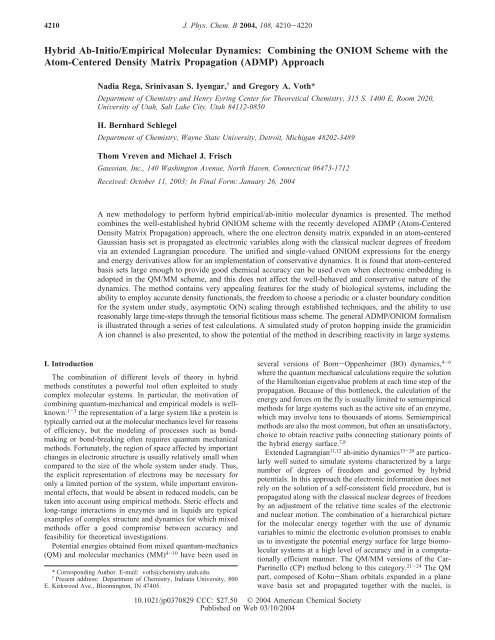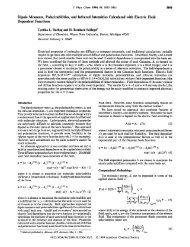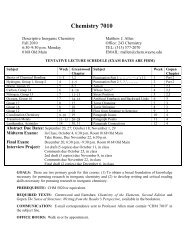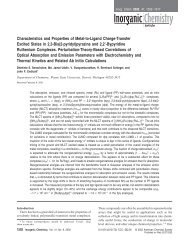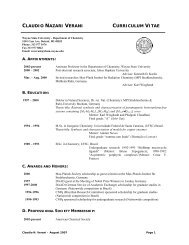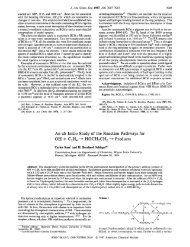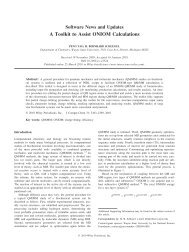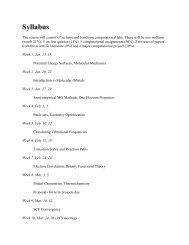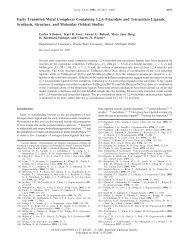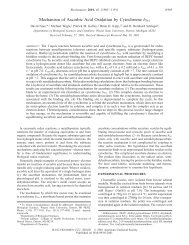Hybrid Ab-Initio/Empirical Molecular Dynamics - Wayne State ...
Hybrid Ab-Initio/Empirical Molecular Dynamics - Wayne State ...
Hybrid Ab-Initio/Empirical Molecular Dynamics - Wayne State ...
Create successful ePaper yourself
Turn your PDF publications into a flip-book with our unique Google optimized e-Paper software.
4210 J. Phys. Chem. B 2004, 108, 4210-4220<strong>Hybrid</strong> <strong>Ab</strong>-<strong>Initio</strong>/<strong>Empirical</strong> <strong>Molecular</strong> <strong>Dynamics</strong>: Combining the ONIOM Scheme with theAtom-Centered Density Matrix Propagation (ADMP) ApproachNadia Rega, Srinivasan S. Iyengar, † and Gregory A. Voth*Department of Chemistry and Henry Eyring Center for Theoretical Chemistry, 315 S. 1400 E, Room 2020,UniVersity of Utah, Salt Lake City, Utah 84112-0850H. Bernhard SchlegelDepartment of Chemistry, <strong>Wayne</strong> <strong>State</strong> UniVersity, Detroit, Michigan 48202-3489Thom Vreven and Michael J. FrischGaussian, Inc., 140 Washington AVenue, North HaVen, Connecticut 06473-1712ReceiVed: October 11, 2003; In Final Form: January 26, 2004A new methodology to perform hybrid empirical/ab-initio molecular dynamics is presented. The methodcombines the well-established hybrid ONIOM scheme with the recently developed ADMP (Atom-CenteredDensity Matrix Propagation) approach, where the one electron density matrix expanded in an atom-centeredGaussian basis set is propagated as electronic variables along with the classical nuclear degrees of freedomvia an extended Lagrangian procedure. The unified and single-valued ONIOM expressions for the energyand energy derivatives allow for an implementation of conservative dynamics. It is found that atom-centeredbasis sets large enough to provide good chemical accuracy can be used even when electronic embedding isadopted in the QM/MM scheme, and this does not affect the well-behaved and conservative nature of thedynamics. The method contains very appealing features for the study of biological systems, including theability to employ accurate density functionals, the freedom to choose a periodic or a cluster boundary conditionfor the system under study, asymptotic O(N) scaling through established techniques, and the ability to usereasonably large time-steps through the tensorial fictitious mass scheme. The general ADMP/ONIOM formalismis illustrated through a series of test calculations. A simulated study of proton hopping inside the gramicidinA ion channel is also presented, to show the potential of the method in describing reactivity in large systems.I. IntroductionThe combination of different levels of theory in hybridmethods constitutes a powerful tool often exploited to studycomplex molecular systems. In particular, the motivation ofcombining quantum-mechanical and empirical models is wellknown:1-3 the representation of a large system like a protein istypically carried out at the molecular mechanics level for reasonsof efficiency, but the modeling of processes such as bondmakingor bond-breaking often requires quantum mechanicalmethods. Fortunately, the region of space affected by importantchanges in electronic structure is usually relatively small whencompared to the size of the whole system under study. Thus,the explicit representation of electrons may be necessary foronly a limited portion of the system, while important environmentaleffects, that would be absent in reduced models, can betaken into account using empirical methods. Steric effects andlong-range interactions in enzymes and in liquids are typicalexamples of complex structure and dynamics for which mixedmethods offer a good compromise between accuracy andfeasibility for theoretical investigations.Potential energies obtained from mixed quantum-mechanics(QM) and molecular mechanics (MM) 4-10 have been used in* Corresponding Author. E-mail: voth@chemistry.utah.edu.† Present address: Department of Chemistry, Indiana University, 800E. Kirkwood Ave., Bloomington, IN 47405.several versions of Born-Oppenheimer (BO) dynamics, 4-6where the quantum mechanical calculations require the solutionof the Hamiltonian eigenvalue problem at each time step of thepropagation. Because of this bottleneck, the calculation of theenergy and forces on the fly is usually limited to semiempiricalmethods for large systems such as the active site of an enzyme,which may involve tens to thousands of atoms. Semiempiricalmethods are also the most common, but often an unsatisfactory,choice to obtain reactive paths connecting stationary points ofthe hybrid energy surface. 7,8Extended Lagrangian 11,12 ab-initio dynamics 13-20 are particularlywell suited to simulate systems characterized by a largenumber of degrees of freedom and governed by hybridpotentials. In this approach the electronic information does notrely on the solution of a self-consistent field procedure, but ispropagated along with the classical nuclear degrees of freedomby an adjustment of the relative time scales of the electronicand nuclear motion. The combination of a hierarchical picturefor the molecular energy together with the use of dynamicvariables to mimic the electronic evolution promises to enableus to investigate the potential energy surface for large biomolecularsystems at a high level of accuracy and in a computationallyefficient manner. The QM/MM versions of the Car-Parrinello (CP) method belong to this category. 21-24 The QMpart, composed of Kohn-Sham orbitals expanded in a planewave basis set and propagated together with the nuclei, is10.1021/jp0370829 CCC: $27.50 © 2004 American Chemical SocietyPublished on Web 03/10/2004
<strong>Hybrid</strong> <strong>Ab</strong>-<strong>Initio</strong>/<strong>Empirical</strong> <strong>Molecular</strong> <strong>Dynamics</strong> J. Phys. Chem. B, Vol. 108, No. 13, 2004 4211combined with MM calculations consisting of classical dynamicsusing empirical force fields. However, the use of delocalizedplane-wave basis functions in a QM/MM system renders thechoice of box size to be extremely critical, since the QM systemcan be thought of as a cluster placed in an MM environment.As noted in ref 15, neutral clusters are generally treated in planewave basis sets using the super-cell method, where the size ofthe cell is made large so that the periodic images do not interactwith each other. This, however, can lead to serious issues withina QM/MM scheme where a large box might result in MM atoms(and charges) being present inside the supercell box where thebasis functions have nonzero amplitudes. On the contrary,making the plane-wave box size small also has serious repercussionson account of artifacts from periodic boundary conditions.Charged molecular clusters in a vacuum (in the absence of MMatoms that might be present in a QM/MM treatment) have beentreated 15 using plane-waves, by explicitly removing the longrangeelectrostatic contributions of the charged species byintegrating the Poisson equation. By contrast, the implementationof the correct physical boundary conditions for a localized QMsystem is more natural with atom-centered basis functions andvery little special care is necessary.In this paper we wish to present a novel methodology toperform a combined ab-initio/empirical molecular dynamicsbased on an extended Lagrangian approach. To this end, therecently developed ADMP (Atom-centered basis functionsDensity Matrix Propagation) ab-initio dynamics method 16-20 iscombined with the ONIOM 25-33 approach to perform hybridpotential calculations.ONIOM is a method for combining calculations using a highlevel of theory on a part of a large system with lower levelcalculations on the full system. In its full generality, ONIOMcan combine several levels of theory and corresponding modelsystems within one calculation. However, the present workfocuses on using two levels of theory, one a quantum mechanical(MO) method and the other <strong>Molecular</strong> MechanicssONIOM(MO:MM)sto produce a particular QM/MM method.The ONIOM QM/MM model is distinguished from most QM/MM models in two ways:1. ONIOM uses additivity to integrate the energies (and otherproperties, such as energy derivatives) from the constituentmodels, rather than solving a problem involving one Hamiltoniancontaining terms from the different models. Consequently,the individual calculations which contribute involve standardQM or MM methods, allowing all the existing functionality forcalculations on the uncorrected model system to be carried over.In particular, any QM method can be used with ONIOM(MO:MM) and the implementation of ADMP for the pure MO casecarries over virtually unchanged to the ONIOM(MO:MM) case.2. The coordinates of the link atoms required when bondsare truncated to form the model system are well-definedfunctions of the Cartesian coordinates of the atoms in the bondin the real system, so that all component energies are smoothfunctions of the coordinates of the atoms in the real system.Consequently, potential energy surfaces for the ONIOM integratedenergy are well-defined, and it is possible to conductdynamics using the ONIOM energies and forces.QM/MM models have a long history 1-3 and have been usedfor dynamics on the Born-Oppenheimer surface since theirinception. More recently, Ziegler and co-workers have used theirvariant of the earlier IMOMM method of Morokuma to performCP dynamics. 23,24A good ONIOM model should produce (a) results forproperties which primarily involve atoms in the model systemwhich are similar to those predicted by the high-level calculationapplied to the real system, and which are closer to the highlevelcalculation on the real system than the uncorrected highlevelcalculation on the model system, and (b) results forproperties involving the other atoms which are no worse thanthe low-level calculation on the real system. Morokuma andco-workers have also introduced a novel QM/MM scheme tofacilitate more efficient Born-Oppenheimer dynamics. 34 Thisapproach allows for exchange of particles between the twolayers, by introduction of a buffer zone, and results in adynamics scheme that is shown to conserve energy.In the ADMP approach, the one-electron density matrix isexpanded in an atom-centered (Gaussian) basis and is propagatedas electronic variables. A comparative study of ADMP andBorn-Oppenheimer dynamics 18 has shown that the currentimplementation of ADMP is a factor of 4 faster than Born-Oppenheimer dynamics 18 for each time-step. Born-Oppenheimerdynamics can, at the most, allow a time-step twice aslarge as that allowed in ADMP 18 while maintaining similarenergy conservation when the same integrator (velocity Verlet)is used. This is on account of reasonably large time-steps alreadyallowed within ADMP through efficient use of the tensorialfictitious mass scheme. 17 This renders the current implementationof ADMP within the Gaussian suite of electronic structurecodes 35 to be at least a factor of 2 faster than Born-Oppenheimerdynamics for a given total trajectory time. This offerscomputational advantages over other semiempirical/MM Born-Oppenheimer dynamics methods for QM/MM dynamics. Incomparison to traditional semiempirical/MM Born-Oppenheimerdynamics, ADMP is more efficient when using the sameQM model and ADMP can be applied using more accurate QMmodels, including Hartree-Fock and pure or hybrid DFT. Thelatter is particularly important for studies of reactivity inbiological systems, because semiempirical methods have limitedaccuracy for transition state structures and reaction paths,especially when transition metals are involved. In comparisonto the CP method using a plane wave basis, ADMP has theadvantage of being able to employ hybrid density functionals,which are known to be of substantially better accuracy indescribing activation energies, especially when motion ofhydrogens is involved, and in describing hydrogen bonds.Another important advantage is that atom-centered functionscan be used with the correct physical boundary conditions formolecules, polymers, surfaces, and solids, without the need totreat replicated cells in order to impose 3d periodicity. Consequently,charged systems and QM/MM models can be treatedas easily as neutral molecules and long-range interactions canbe introduced using periodic boundary conditions. Alternatively,the QM/MM system can be treated as a cluster where differentlayers interact to a small, even if significant, extent, and longrangeinteractions can be included using a suitable continuumsolvent model.Another crucial issue when hybrid methods are employed totreat large systems is the computational efficiency. The ADMP/ONIOM approach shows an asymptotic O(N) scaling by virtueof established techniques 36 and the capability of employingreasonably large time-steps through the use of a tensorialfictitious mass. Finally, ADMP allows one to treat all electronsin the QM region of the system explicitly without resorting topseudopotentials (unless so desired), and to systematicallycontrol the deviation from the Born-Oppenheimer surface andthe resulting mixing of fictitious and real kinetic energies. Itmust be noted here that the Projector-Augmented Wave (PAW) 37approach and novel Car-Parrinello schemes using both Gaussian
4212 J. Phys. Chem. B, Vol. 108, No. 13, 2004 Rega et al.and Plane wave basis sets 38,39 can also allow the treatment ofcore electrons, although not in as complete a fashion as ispossible within the ADMP approach. In this regard, it isparticularly interesting to discuss a new approach to the CPscheme 40 that uses Wannier basis functions 41,42 instead of planewaves to represent the electronic structure. The Wannier basisfunctions 41,42 are unitary transforms of the plane-wave basis sets,generated under the condition of maximal spatial localizationof the resultant basis functions. In ref 40, the Wannier basisfunctions are used to represent the CP orbitals, and these basisfunctions are propagated simultaneously along with the molecularorbital coefficients using the same fictitious mass as themolecular orbital coefficients. In this regard, this approach isquite similar to the floating Gaussian approach to Car-Parrinellodynamics 43 where Gaussian basis function centers and widthsare simultaneously propagated using a fictitious mass.The present paper is organized as follows. In Section 2, theADMP/ONIOM algorithm is described. Section 3 is thendedicated to the discussion of a few applications aimed atvalidating the accuracy and stability of the simulations and thereliability of the QM/MM interface coupling of the ONIOMpotential. We also present preliminary results of a study currentlyin progress on the proton translocation inside the ion channelgramicidin A, to show the potential of the method in describingreactivity in large systems. Concluding remarks are thenprovided in Section 4.II. The ADMP/ONIOM <strong>Molecular</strong> <strong>Dynamics</strong> AlgorithmA. The ONIOM Potential Energy Surface. In the ONIOMscheme, the energy of a system as a whole is expressed as alinear combination of subsystems of different size and atdifferent levels of theory. Here we consider the simplest formof such an approach, involving the definition of a core portion(the model system) of the entire system (the real system), andthe ONIOM combination of QM and MM levels of descriptionyields the expressionE ONIOM ) E MM,real - E MM,model + E QM,model (1)Note that the real system is treated only at the MM level, whilethe model is considered at both the MM and QM levels. Themodel is chosen to capture all of the important quantum effectswhich determine, for example, chemical bond-breaking andformation or rapid change of the electronic polarization.Once the atoms whose interactions require the quantummechanical description have been chosen, the complete modelsystem is generated in one of two ways:1. The model system includes (a) the selected atoms and (b)additional link atoms, typically hydrogens, which terminatebonds between selected atoms and unselected atoms. This isusually termed mechanical embedding, since the couplingbetween the model system and the real one is solely due to themolecular mechanics terms in the MM calculation on the realsystem.2. The model system includes the selected atoms and the linkatoms as in mechanical embedding, and all real system atomsnot selected and not replaced by link atoms are replaced bypoint charges at the same location. This is usually termedelectronic embedding, because the electronic structure in theQM calculation is affected by the charges of the full system.The point charges are typically the same charges used in theMM calculation on the real system, except that to avoid overpolarizationeffects, the charges for atoms within a few bondsof the link atoms are scaled down or set to zero. Note that boththe QM and MM calculations use the same model system,including the point charges. Consequently, the Fock matrix inthe QM calculation depends on the coordinates of all atoms inthe real system, and there are nonzero contributions to the forceson all atoms in the real system from each model systemcalculation.All results reported here use electronic embedding, and thepoint charges in the model system for atoms which are eitherbonded to a link atom or are one bond further removed from alink atom are set to zero.It should be noted that the electronic embedding may beregarded as being possibly incomplete when nonpolarizable MMforce fields are employed. However, average polarization effectscan be included to a certain amount even in force fields notcontaining explicit polarization terms, if the parameters areproperly fitted to the experiment. 44 In addition, recentlydeveloped models such as the Effective Fragment Potential(EFP) approach 45 can be used in the current scheme, and suchmodels could improve the quality of the MM region on accountof a detailed inclusion of polarization effects. However, nopolarizable force field seems to be yet available which has acomplete parametrization and has been systematically tested onbiological systems.An essential ingredient in the definition of hybrid energypotentials is the methodology adopted if chemical bondsintersect the boundary between different layers. When artificialatoms saturate the dangling valences of the model across theboundary (link atoms approach 46 ), the correct number of degreesof freedom and therefore the unique definition of the potentialenergy are ensured by defining the coordinates of the link atomas follows: 31-33r link ) r bond + g(r sub - r bond ) (2)where r bond is the position of the model atom to which the linkis bonded to substitute the atom belonging to the surroundingregion and located in r sub .Ineq2,g is a scale factor, normallyset to R(M-L)/R(M-R), where R(M-L) is a typical bondlength between the model system atom and the link atom (H inall cases in this work), and R(M-R) is a typical bond lengthfor the pair of atoms in the real system. Careful tests have shownthat the ONIOM results are quite insensitive to the value ofg. 30 It must be stressed that, since the link atom positions arefully defined by the coordinates of the real system, the ONIOMenergies and gradients can be written as functions of only realnuclei positions R. Thus, the ONIOM potential as defined in(1) and (2) is single valued and differentiable with respect toR, allowing conservative dynamics to be performed.In the following subsection we shall describe the implementationof ADMP dynamics on an ONIOM potential energy surfaceinvolving link atoms (eqs 1 and 2) and with electronicembedding to treat electrostatic QM/MM interactions in nonpolarizableforce fields.B. The ADMP <strong>Dynamics</strong> Exploiting the ONIOM Potential.The ADMP/ONIOM extended Lagrangian governing thedynamics is formally identical to the Lagrangian exploited forfull ab-initio propagation:L ADMP ) 1 2 Tr(VT MV) + 1 2 Tr([µ1/4 Wµ 1/4 ] 2 ) -E ONIOM (R,P) - Tr[Λ(PP - P)] (3)where the nuclei of the real system are propagated withcoordinates R, velocities V, and masses M, while the electronicdegrees of freedom of the model are propagated with the density
<strong>Hybrid</strong> <strong>Ab</strong>-<strong>Initio</strong>/<strong>Empirical</strong> <strong>Molecular</strong> <strong>Dynamics</strong> J. Phys. Chem. B, Vol. 108, No. 13, 2004 4213matrix P, the density matrix velocity W, and the density matrixfictitious mass tensor µ. Ineq3,P is the density matrix in anorthonormal Gaussian basis set, related to the correspondingmatrix in the nonorthogonal basis, P′, byP ) UP′U T , where Uis the factorization matrix of the nonorthogonal basis overlapmatrix S′ ) U T U. The matrix U can be obtained by Choleskydecomposition 47 or Lowdin symmetric orthonormalization. TheLagrangian multiplier matrix Λ imposes constraints on the totalnumber of electrons and the idempotency of the one-particledensity matrix (the so-called N-representability constraints).Note that while P includes the electronic variables for the modelonly, the potential energy surface also depends on the molecularmechanics energy function through the set of parameters.The formal identity with the full ab-initio dynamics holdsalso for the analysis of the deviations from the Born-Oppenheimer surface. The adiabatic performance of ADMPdynamics has been studied in some detail (see refs. 17, 19). Inparticular, the deviations depend on the magnitude of thecommutator of the Fock and density matrixes [F,P] and on thefictitious mass µ. These quantities are found to be closely interrelatedand the choice of the fictitious mass provides a lowerbound on the deviations from the true BO surface.The Euler-Lagrange equations of motion for the nuclei anddensity matrix expanded in the orthonormal basis set areandM d2 Rdt 2 )-∂EONIOM (R,P)∂R| P(4)µ 1/2 d 2 Pdt 2 µ1/2 )-[ ∂EONIOM (R,P)∂P| R+ ΛP + PΛ - Λ] (5)These equations can be integrated using the velocity Verletalgorithm, 48 while the Lagrangian multiplier matrixes aredetermined by an iterative scheme 16,17 so that P i+1 and W i+1satisfy the idempotency constraint, P 2 ) P, and its timederivative, PW + WP ) W.The force acting on the density matrix (rhs of eq 5) has thesame analytical form as in full ab-initio ADMP∂E(R,P)∂P | R) 3FP + 3PF - 2FP 2 - 2PFP - 2P 2 F (6)In the case of electronic embedding, the Fock matrix, F, includeselectrostatic interactions with all the real system atoms.The nuclear forces in eq 4 are obtained by a simple derivativeof the energy expression in eq 1:∂E ONIOM (R,P)∂R| P) dEMM,real (R)dR- dEMM,model (R)+dR∂E QM,model (R,P)∂R| P(7)The forces in the QM calculation are computed as described inrefs 16, 17, 19, and the model system forces are transformed toreal system forces as described in ref 29. It is, however,important to note here that the nuclear forces in ADMP involveadditional terms that depend on the commutator of the Fockand density matrixes 16,19 unlike those in the standard ONIOMimplementation 29 for Born-Oppenheimer dynamics.The possible unphysical interaction between the QM electronicdensity and the MM nuclei in proximity to the QM/MMboundary is an important source of instability in dynamicsgoverned by potentials mixing quantum models with empiricalforce fields. The MM charges polarize the QM electron densityand this polarization depends on the proximity of the MMcharges. In some situations, it may happen that the electronicbasis functions that are used to describe the QM part mayphysically overlap with the MM positive charges. This couldhappen, for example, when largely delocalized atom-centeredbasis functions are used on the neighboring QM atoms, or whentotally delocalized basis functions (such as plane waves) areused to describe the electronic structure. In either case, thepresence of an MM charge inside the domain of a given basisfunction can create an artificial effect of drawing electrons closeto that MM atom. This is especially true for a bare positivecharge large enough so that an electron binds to it with morebinding energy than the lowest ionization potential of the QMsystem. (A large negative charge may be expected to show theopposite effect.) As stated earlier, one aspect of this overpolarizationcan be taken into account by scaling down the MMcharges in close proximity to the link atoms (i.e., those directlybonded to the substituted atom). 49,50 In the extended Lagrangianapproach, a monitor of the overpolarization event is the heatingof electronic variables. The one-electron matrix that enters intothe forces acting on the density matrix in eq 6 as part of theFock matrix includes interactions between the MM charges andthe QM density, thus directly affecting the integration in thetime of both the density matrix P and its velocity W. IfMMcharges come too close to the electronic density, the elementsof the one-electron matrix increase in magnitude, leading to anartificial acceleration of electronic variables. As a consequence,unphysical dynamics can occur. (This would also affect thefictitious kinetic energy in ADMP dynamics.) Another estimateof this effect may be obtained by monitoring the value of themost diffuse basis functions on the QM/MM boundary atoms(or in the case of plane-waves, just the box size, since all basisfunctions are nonzero inside the box size) and by monitoringthe MM charge in this domain. As we shall illustrate in thenext section, the use of chemically accurate basis sets includingdiffuse functions does not affect the stability of the ADMPdynamics, even when negatively charged molecules are consideredas the QM model. This is not the case for plane-wavebased implementations, where resorting to more complicatedapproaches, such as the smearing-out of the MM charges closeto the QM region through the use of pseudopotentials, becomesmandatory at any level of accuracy of the basis set. 22 Of course,for abnormally large charges (charges with electron affinitygreater than the ionization potential of the QM system),smearing-out of these charges can be a necessity, irrespectiveof the kind of basis set used, especially when these chargesoverlap with the physical extent of the basis set.III. Examples and DiscussionIn this section we discuss some test calculations to highlightthe capabilities of the ADMP/ONIOM method described above.The purpose of the first few cases is to gauge the stability ofthe method. We perform some quality checks with respect tothe most debated issue in hybrid approaches, namely, thebehavior at the QM/MM interface. <strong>Hybrid</strong> methods can showan intrinsic imbalance between two very different molecularpictures: atomic charges and vdW parameters optimized ad hocfor a self-consistent force field can give poor performances whencombined with QM calculations, in particular in evaluating theinteractions involved at the QM/MM boundaries. A number ofQM/MM approaches produce a poor description for the firstsolvation shell of a QM molecule or ion embedded in a MM
4214 J. Phys. Chem. B, Vol. 108, No. 13, 2004 Rega et al.environment. These problems can be overcome to some degreeby an intellingent choice of the model, so that all the importantfeatures affecting the phenomenon under study are included and,when possible, to avoid important interactions such as hydrogenbonds and, more general, strong changes in electric polarizationat the QM/MM boundaries. These latter requirements cannotbe easily fulfilled when charged or strongly polarized QMsystems are involved, for example, in biological systems.Furthermore, the inclusion of the MM atomic charges in theQM Hamiltonian can lead also to unphysical effects as discussedearlier, and part of the electronic density can artificially localizeon positively charged MM atoms (electronic spill-out). In thecase of extended Lagrangian approaches, this can lead to theheating of electrons and can cause unphysical dynamics. 22To gauge the ADMP/ONIOM method in these respects, wehave simulated the S N 2 reaction of methyl chloride with achloride ion starting from the (Cl-CH 3 -Cl) - transition state(the model) embedded in a MM water cluster. Due to the excessnegative charge, large basis sets are mandatory to allowflexibility in both the radial and the angular part of the electronicdistribution, through the inclusion of diffuse and polarizationfunctions, respectively. Therefore such a system is particularlysuitable to probe the stability of the method with respect topossible spill-out effects at the interface and over-polarizationof the QM wave functions due to the MM charges. It must,however, be noted that the choice of model here (only (Cl-CH 3 -Cl) - ) is being used to test the ADMP/ONIOM approachand in a full production calculation some of the water moleculessurrounding (Cl-CH 3 -Cl) - should probably be included in themodel region for the best results.As a further test we considered the simulation of (i) a chlorideion and (ii) a water molecule, inside an MM water cluster. Thelatter system may be seen as a prototypical of a hydrogenbonding system treated at the QM/MM level. In both cases theradial distribution functions involving QM and MM atoms wasanalyzed to gauge the behavior of the ADMP/ONIOM potentialat the QM/MM interface.As a last example in the present study the proton hoppingbetween two water molecules was simulated inside the gramicidinA ion-channel. This example is designed to show thecapabilities of the ADMP/ONIOM method in elucidating protontransfermechanisms, an essential event in biological chemistry.Proton hopping in transmembrane channels constitutes a challengefor the theoretical description of large systems due to theinvolvement of extensive hydrogen bond networks and thepresence of transmembrane electric fields.All the ADMP/ONIOM calculations have been performedusing a development version of the Gaussian 35 suite of programs,while MD simulations using the DL-Poly 51 program furnishedthe starting configuration for all systems. The level of theoryemployed to build the ONIOM potential was density functionaltheory along with the standard 6-31G(d), 6-31G(d,p), and6-31+G(d,p) basis sets. In particular, we used the BLYP densityfunctional, combining the Becke 52 exchange terms with theLee-Yang-Parr 53 correlation functional and the hybrid B3LYPfunctional, that also includes the Hartree-Fock exchange termsin the same ratios as those optimized by Becke. 54 The AMBER 55set of parameters together with the TIP3P 56 water modelprovided for the MM force field.A. (Cl-CH 3 -Cl) - f Cl - + CH 3 Cl in Water Cluster. Thenucleophilic substitution (S N 2) reaction (X - + CH 3 Y f Y - +CH 3 X) is considered as a benchmark reaction in the study ofchemical reactivity in aqueous solution. 57,58 However, thepurpose of the current study is the demonstration of the ADMP/Figure 1. The ADMP/ONIOM trajectory for the Cl-CH 3-Cl f CH 3-Cl + Cl - S N2 reaction. Time evolution of the fictitious kinetic energyand the change in the difference between the total and the fictitiouskinetic energy (10 -3 au).ONIOM procedure and not the mechanism of the processinvolved. The isolated transition state (Cl-CH 3 -Cl) - wasobtained by a B3LYP/6-31+G(d,p) calculation. This structurewas then fixed at the center of a cubic periodic box of length45 Å with water molecules surrounding the ion, and a classicMD simulation was performed at normal density using theAMBER force field and TIP3P water model. Standard AMBERparameters were used to treat the chloride ion and methyl group.After 100 ps of equilibration, a cluster containing the (Cl-CH 3 -Cl) - subsystem (the model) and the closest 256 water moleculeswas selected from the simulation box and used as the startingstructure in the ADMP/ONIOM simulation.To perform the ADMP/ONIOM simulation, the same MMforce field was retained while B3LYP/6-31+G(d,p) was the QMlevel of theory. The core and valence orbitals [for the (Cl-CH 3 -Cl) - subsystem] were weighted differently during thedynamics with µ valence ) 0.1 amu bohr 2 ≈ 180 au for the valenceelectrons, using the tensorial fictitious mass scheme describedin ref 17 to obtain improved adiabatic control. (The tensorialfictitious mass scheme fixes the effective mass of the coreelectrons based on µ valence and Fock matrix elements.) Thesystem was simulated in a constant NVE ensemble, and ∆t )0.25 fs was the time step for a trajectory of 180 fs duration, thetime required to get well-separated products.In Figures 1 and 2, some important parameters reflecting theaccuracy of the ADMP trajectory are reported. The fluctuationin the total energy conservation is 0.6 millihartree, which issimilar to that found in other full ab-initio ADMP simulationsperformed using similar values of time step and fictitiousmass. 16-18 Furthermore, no significant heating of the densitymatrix was observed, which indicates that no fraction of theelectron density moves artificially to localize on MM atoms.In Figure 2, the Frobenius norm of the Fock and density matrixescommutator, ||[F,P]|| F , and the adiabaticity index, dH fict /dt, givea measure of the deviation of the extended Lagrangian trajectoryfrom a Born-Oppenheimer dynamics trajectory. 19 The smallorder of magnitude of these values demonstrates that the QM/MM combination in the Hamiltonian does not alter the accuracyof the extended Lagrangian dynamics and the dynamics remainsclose to the corresponding Born-Oppenheimer surface. Hence,in this example, the ADMP/ONIOM approach allows for stablesimulations, even in the presence of external fields (treated withan inclusion of point charges in the Hamiltonian) and chargedQM systems described by large basis sets.B. QM Chloride Ion and Water Molecule in an MMWater Cluster. The B3LYP/6-31+G(d,p) level of theory andthe AMBER/TIP3P force field was employed to perform anADMP/ONIOM simulation of a chloride ion embedded in acluster of 256 water molecules. A procedure analogous to that
<strong>Hybrid</strong> <strong>Ab</strong>-<strong>Initio</strong>/<strong>Empirical</strong> <strong>Molecular</strong> <strong>Dynamics</strong> J. Phys. Chem. B, Vol. 108, No. 13, 2004 4215Figure 2. Time evolution of adiabaticity index (in 10 -3 Hartree/fs)and the Frobenius norm ||[F,P]|| F for the Cl-CH 3-Cl f CH 3Cl +Cl - S N2 reaction in the ADMP/ONIOM simulation.adopted for the previous example provided for the startingconfiguration. The simulation time step was ∆t ) 0.25 fs anda valence fictitious mass of µ valence ) 0.1 amu bohr 2 ≈ 180 auwithin the tensorial fictitious mass scheme was chosen. Energyand structure data were sampled for 3 ps after ADMP/ONIOMequilibration of 2 ps.In Figure 3 the chloride-oxygen and the chloride-hydrogenradial distribution functions (RDF) are shown for the ADMP/ONIOM simulation. All RDFs in this paper were calculated inthe following fashion. The number of events inside a certainbin-size was calculated from the ADMP trajectory. This numberwas then divided by the total number of configurations used(indicative of the length of the trajectory), volume inside thespherical shell created by the chosen bin-size, and the numberdensity of the system. The Cl-O RDF shows a maximum atabout 3.3 Å, while the first two peaks of the Cl-H RDF arelocated at about 2.3 and 3.7 Å, respectively. Thus the firstsolvation shell of the chloride ion is reproduced reasonably wellwith respect to the experimental values 59 from neutron defractionstudy of chloride ion in liquid water (3.25 Å for Cl-O, and2.29 and 3.66 Å for two Cl-H peaks, respectively). Also inthis case we observe a good behavior of the parametersgoverning the dynamics. The total energy is conserved to within2 × 10 -4 hartree, while the maximum value of the fictitiouskinetic energy is 1.4 × 10 -7 hartree. Furthermore, the adiabaticityindex was less than or equal to 2.4 × 10 -7 and theFrobenius norm of the Fock and density matrix commutator,[F,P], had a maximum value of 4.05 × 10 -4 , which were bothwell inside the expected range for retaining adiabatic dynamics.With these results we were able to ascertain that our QM/MMdynamics scheme was stable and the adiabaticity was wellmaintainedthrough the dynamics of this test system.Radial distribution functions involving a model water moleculein a MM water cluster have been studied by other authorsat several levels of QM/MM dynamics. 21,60 These RDF generallyshow shifts with respect to experimental values indicating toostrong a QM/MM interaction; in particular an over polarizationof the electronic cloud has been indicated as being possiblyFigure 3. Pair correlation functions for a QM chloride ion (the model)embedded in a cluster of 256 MM water molecules. All radialdistribution functions in this paper were calculated in the followingfashion. The number of events inside a certain bin-size was calculatedfrom the ADMP trajectory. This number was then divided by the totalnumber of configurations used (indicative of the length of the trajectory),volume inside the spherical shell created by the chosen bin-size, andthe number density of the system.Figure 4. ADMP/ONIOM simulation of a water molecule in a watercluster performed at B3LYP/6-31G(d,p)/Amber level: pair correlationfunction involving the model oxygen and the oxygens in the surroundingMM molecules (solid line), and pair correlation function of oxygenatoms contained in the MM region (dotted line).responsible for this trend. An ADMP/ONIOM simulation of awater cluster of 256 molecules was performed in the presentwork in which the central water of the initial configuration isthe model and was treated at the B3LYP/6-31G(d,p) level. TheTIP3P potential was employed for the MM level. A classicalMD simulation performed for 100 ps at 300 K provided for thestarting configuration. Data were then collected for 3 ps at thesame temperature after a ADMP/ONIOM equilibration of 2 ps.The simulation time step was ∆t ) 0.2 fs and µ valence ) 0.1amu bohr 2 was employed.In Figure 4, the RDF between the oxygen of the model andthe oxygens belonging to the MM water molecules is comparedwith the radial distribution function for the oxygen atomsbelonging to the water molecules in the MM region. The firstpeak of the RDF is in very good agreement between the twopanels of the figure. Since the TIP3P water model is known to
4216 J. Phys. Chem. B, Vol. 108, No. 13, 2004 Rega et al.Figure 5. ADMP/ONIOM simulation of a water molecule in a watercluster performed at B3LYP/6-31G(d,p)/Amber level. Pair correlationfunction involving the model oxygen and the embedding hydrogens(solid) and the model hydrogens and the embedding oxygens (dotdash)are compared with the pair correlation function for the MM leveloxygen and hydrogens (shown using dotted lines).reproduce the water radial distribution function reasonablyaccurately, we are inclined to interpret this agreement betweenthe O QM -O MM and O MM -O MM RDFs as indicating that our QM/MM interface does not introduce significant artifacts into ourcalculations.In Figure 5 the three possible oxygen-hydrogen RDFsinvolving the model and the surrounding waters are reported.In this case the picture of the first solvation shell of the QMsolute is satisfactory. In Figures 4 and 5, first solvation shellvalues about 2.7, 1.8, and 1.7 Å for the O QM -O MM ,O QM -H MM , and H QM -O MM distributions are obtained, respectively.Note that these results involving QM and MM atoms are closeto those provided by the TIP3P water model (2.72 Å for theoxygen-oxygen and 1.78 Å for the oxygen-hydrogen distances).Thus, there is no apparent evidence of a dramatic overpolarizationeffect in these cases.When we compare a hybrid calculation with its full quantummechanical counterpart, MM charges account for the polarizationof the model electronic cloud, while the repulsion betweenQM and MM atoms is represented by the vdW MM energyterms, and the possible charge transfer between orbitals belongingto MM and QM atoms is naturally absent. The differencewith respect to a full ab-initio description relies on thisapproximation and the performance of hybrid potentials stronglydepend on the specific combination of the QM level of theoryand MM functionals. Nevertheless, the examples given abovedemonstrate that the use of standard nonpolarizable force fieldswithin an electronic embedding scheme as depicted in sectionII can provide well-behaved ADMP/ONIOM dynamics and areasonable description of the interactions at the QM/MMinterface.C. Proton Transfer in Gramicidin A. As a further test, themechanism of proton hopping in the transmembrane channelgramicidin A was examined. This system has been consideredan important case to elucidate the mechanism of ion transportand has been widely investigated both theoretically and experi-Figure 6. The real system for the ADMP/ONIOM dynamics for the proton translocation in gramicidin A.
<strong>Hybrid</strong> <strong>Ab</strong>-<strong>Initio</strong>/<strong>Empirical</strong> <strong>Molecular</strong> <strong>Dynamics</strong> J. Phys. Chem. B, Vol. 108, No. 13, 2004 4217mentally. (For a general overview of the computational studieson gramicidin A channel, see ref 61; see also ref 62 for an abinitiostudy on a model analogue of gramicidin A.)The gramicidin A channel is formed by two β helices, eachconstituted by 15 alternating D- and L-amino acids. Thisconformation allows the polar groups of the peptides chain topoint inward to the channel, while the hydrophobic side chainsare embedded in the transmembrane lipids. Ion transport, inparticular the proton Grotthuss mechanism along a water chainaccommodated in the channel, involves a highly correlatedhydrogen bond network in a strongly polarized system. Furthermore,the application of external electric fields is requiredto simulate the applied gradient potential during the experiments.The real system considered here includes the gramicidin Aand 18 water molecules for a total of 607 atoms (see Figure6a). Eight of these water molecules are contained inside thechannel, while the remaining water molecules form suitable capsto the channel. The starting configuration for the ADMP/ONIOM dynamics was selected from an equilibrated classicalMD simulation using the Multi-<strong>State</strong> <strong>Empirical</strong> Valence Bondmodel. 63-67 This initial structure places the excess proton onthe water molecule just inside the channel mouths (water no.1). The proton translocation is expected to be modulated bythe hydrogen bond network involving both the water moleculesand the polar groups of the peptidic chain. Hence, the modelwas chosen to include part of the Gramicidin backbone and thewhole set of water molecules. The dangling valences aresaturated by link hydrogens atoms. The model includes a totalof 156 atoms (see Figure 7. (For the time-scales involved inthis study, the proton remained inside the top monomer of theGramicidin backbone. This justified including only the proteinbackbone from the top monomer in the model while the bottommonomer was treated within the MM framework.)Two ADMP/ONIOM simulations were performed using theBLYP/6-31G(d) and the B3LYP/6-31G(d) QM levels togetherwith the AMBER MM force field. Values of µ valence ) 0.1 amubohr ≈ 180 au and ∆t ) 0.2 fs were used and a constanttemperature of 300 K was enforced by velocity re-scaling every2 fs. A homogeneous electric field of 2. × 10 -4 au (≈280 mV)was applied along the channel axis to simulate the gradient ofelectrostatic potential during the experiments (usually about 200mV - 400 mV) to drive the proton translocation. Harmonicconstraints were employed to fix the position of the oxygensbelonging to the capping water molecules.To proceed further with our discussion we recognize that forthe energy expression in eq 1, the interaction of the MM chargeswith the charges on the model atoms, at the MM level of theory(electronic embedding), occurs in the first two terms of eq 1.However, due to the opposite sign of these terms, thesecontributions cancel out for almost all atoms in the system.Hence, it is arbitrary what charges are picked for the atoms inthe model system during the MM calculation. On account ofthis, all the atoms in the portion of the model system mostsusceptible to bond breaking and formation, i.e., the water wireinside the gramicidin channel, were chosen to have zeromolecular mechanics charges at both the real MM and modelMM calculations. This cancellation works out for all the modelatoms except for the ones whose charges are scaled (or set tozero) to avoid over-polarization. (See the discussion in the lastparagraph of section II.) The interaction between these “scaled”charges and the model atoms do not cancel between the realand model MM calculations (since the charges are scaled onlyduring the calculation of the second and third terms in eq 1),and it is here that the choice of the model charges could affectFigure 7. The 156 atom model (QM) system for the ADMP/ONIOMdynamics for the proton translocation in gramicidin A.the physics of the problem. However, to nullify this effect, carewas taken to choose the scaled atoms as the ones that alreadyhad small values for charges in the real MM calculation, thusreducing this effect substantially. Furthermore, the effect ofscaling does not alter the total charge of the system in a seriousfashion, for the same reason discussed above.The time scales accessible to ab-initio dynamics (on the orderof picoseconds) prohibit the simulation of the entire transmembraneprotein translocation (on the order of nanoseconds), butit is sufficient to give insights on the intrisic mechanism of theproton hopping. In both simulations, the starting structure hasno barrier for the first proton hop and this occurs to water no.2 inside the gramicidin channel. The excess proton remainslocalized between water no. 2 and water no. 3 for about half apicosecond. The simulations were stopped when the hop fromwater no. 2 to water no. 3 was almost complete (500 fs for theBLYP and 650 fs for the B3LYP dynamics, respectively).In Figures 8-12, the BLYP and B3LYP dynamics arecompared. Figure 8 shows the radial distribution of oxygenoxygendistances of the first four waters inside the channel.
4218 J. Phys. Chem. B, Vol. 108, No. 13, 2004 Rega et al.Figure 8. Pair correlation functions for the oxygen-oxygen distancesof the first four chain waters inside the Gramicidin channel.Figure 11. The ADMP/ONIOM trajectory obtained at B3LYP/6-31G-(d)/Amber level for the proton translocation in gramicidin A. Progressof the distances between the excess proton and the oxygens of the donorand the acceptor waters, respectively.Figure 9. The ADMP/ONIOM trajectory obtained at the BLYP/6-31G(d)/Amber level for the proton translocation in gramicidin A.Progress of the distances between the excess proton and the oxygensof the donor and the acceptor waters, respectively.Figure 10. The ADMP/ONIOM trajectory obtained at BLYP/6-31G-(d)/Amber level for the proton translocation in gramicidin A. Progressof the oxygen-oxygen distances between the donor and the acceptorwaters and between the acceptor and the carbonyl of tryptophan 9.Distance values are spread in the range between 2.3 and 3.0 Åwith a large distribution between 2.45 and 2.7 Å. These valuesare similar to those seen for the Zundel-like (H 5 O 2 + ) and theEigen-like (H 9 O 4 + ) protonated complex present in bulk water.The Eigen-like arrangement can be obtained in this case withthe channel carbonyl groups completing the necessary hydrogenbond network. It is worth noting that the distribution obtainedwith the BLYP functional shows a larger contribution correspondingto the Eigen complex as compared to that found usingB3LYP, where in the latter case the distribution is mostlyconcentrated on values below 2.6 Å. This difference betweenlevels of DFT treatment is in agreement with that observed inprevious ADMP studies of protonated water clusters. 68In Figures 9-12, we compare the BLYP and the B3LYPbehavior in the time evolution of some atomic distances ofinterest. In Figures 9 and 11 we show the distances betweenFigure 12. The ADMP/ONIOM trajectory obtained at B3LYP/6-31G-(d)/Amber level for the proton translocation in gramicidin A. Progressof the oxygen-oxygen distances between the donor and the acceptorwaters and between the acceptor and the carbonyl of tryptophan 9.the excess proton and the oxygens belonging to the second andthe third water (the donor and the acceptor, respectively, forthe majority of the trajectory). Figures 10 and 12 show theoxygen-oxygen distances between the donor and the acceptorwaters together with the distance between the acceptor oxygenand its solvating carbonyl, namely, from the tryptophan 9 alongthe gramicidin peptide chain.Note that in the BLYP case the transient proton approachesthe acceptor water around 100 fs, but most of the time it islocated on the donor water. Temporary hops to the acceptoroccur when the donor water is close to the acceptor (wat don )O-O(wat acc ), compare Figures 9 and 10. Also, when the Trp9-(C)O-O(wat acc ) distance is less than 2.65 Å, there is a noticeabledecrease of the (wat don )O-O(wat acc ) motion amplitude, leadingto an oxygen-oxygen distance closer to a Zundel-like value(≈2.4 Å). During one of these events, the final hopping to theacceptor water molecule occurs (at about 350 fs). Interestingly,after about 300 fs, the motion of the excess proton seems lesscorrelated with the motion of the carbonyl group hydrogenbinding to the acceptor oxygen. This suggests that other factorsmay come into play toward the end of the proton hop to stabilizethe event.A different trend is observed when the results from thedynamics performed at the B3LYP level are considered. Herethe oxygen-oxygen distance of the donor and the acceptorwaters evolves according to a Zundel-like arrangement alongthe whole trajectory, and the excess proton is localized on boththe donor and the acceptor over time (see Figures 11 and 12).Furthermore, the Trp9(C)O-O(wat acc ) distance show valuesbelow 2.9 Å for most of the time, and the correlation of motionsinvolving the protonated complex and the solvating tryptophancarbonyl is less evident.
<strong>Hybrid</strong> <strong>Ab</strong>-<strong>Initio</strong>/<strong>Empirical</strong> <strong>Molecular</strong> <strong>Dynamics</strong> J. Phys. Chem. B, Vol. 108, No. 13, 2004 4219The short time scale investigated here and the small statisticalsample prohibit general conclusions on the comparison of thetwo DFT functionals considered, although there do appear tobe qualitative differences between the two levels of DFT indescribing the proton hopping dynamics. A more comprehensivestudy of the proton hopping dynamics and the differencesbetween levels of DFT will be the topic of future research.IV. Concluding RemarksIn this paper, a new methodology has been presented toperform hybrid ab-initio/empirical molecular dynamics. Themethod combines the hybrid ONIOM scheme with the ADMPmethodology, in which the one-electron density matrix, asexpanded in an atom-centered Gaussian basis set, is propagatedusing fictitious variables within an extended Lagrangian approach.The resulting ADMP/ONIOM formalism has been analyzedfor the general case, including the presence of link atoms tosaturate dangling valences and a standard electronic embeddingscheme to describe the electrostatic interactions between theQM and the MM parts. In this work, a nonpolarizable MM forcefield was assumed, but generalization to polarizable MM forcefieldsis clearly possible. Since the link atom positions are fullydefined by the coordinates of the real system, a unique definitionof the ONIOM potential exists that is single-valued anddifferentiable with respect to the real coordinates R, thusallowing conservative dynamics to be performed. Due to theintegrated expressions of the ONIOM energy and energyderivatives, a formal identity with the Lagrangian is obtainedgoverning the ab-initio dynamics. This identity also holds forthe analysis of the deviations from the Born-Oppenheimersurface. The combination of hybrid terms within the forces wasanalyzed in detail. The force acting on the density matrix isseen to have the same analytical form as in full ab-initio ADMP.However, it is affected by the MM environment via the Fockmatrix F, including the electrostatic interactions with the MMregion.To test the ADMP/ONIOM method for possible unphysicalinteractions between the QM electronic density and the MMnuclei in proximity to the QM/MM boundary, the S N 2 reactionof methyl chloride plus a chloride ion was simulated startingfrom the (Cl-CH 3 -Cl) - transition state (the model) embeddedin a MM water cluster. Due to the excess negative charge, thestandard 6-31+G(d,p) basis set was adopted, including diffuseand polarization functions. The total energy was well conservedduring the dynamics, and the fictitious kinetic energy remainedvery small, indicating that no significant heating of the densitymatrix occurs. Furthermore, adiabatic control indices demonstratedthat the QM/MM combination in the Hamiltonian doesnot alter the adiabaticity of the extended Lagrangian dynamics.Hence, the localized picture provided by the electronic expansionover an atom-centered basis set appears to allow for wellbehavedsimulations even when chemically accurate basis setsfor charged systems are employed, together with a standardelectronic embedding scheme to describe QM/MM interactions.The simulation in a MM water cluster of a QM chloride ionand a QM water molecule were also carried out. RDFs obtainedfor the distances involving QM and MM atoms also indicate areasonable description of the interactions at the QM/MMinterface.As a more complicated preliminary application, the resultsfrom BLYP and the hybrid B3LYP functionals were comparedin two analogous simulations of a proton hopping between twowater molecules inside the gramicidin A channel. In the BLYPcase, a transfer mechanism was observed via the formation ofan Eigen-like complex involving a carbonyl group solvating theacceptor water. In the B3LYP case, the formation of the Eigenlikecomplex is less probable and the correlation of motionsinvolving the protonated complex and the peptidic carbonyl lessevident. The implementation and testing of the hybrid ADMP/ONIOM methodology for a variety of complex systems will bethe topic of future research.Acknowledgment. This work was supported by the Officeof Naval Research (G.A.V.), the National Science FoundationGrant CHE-0131157 (H.B.S.), and Gaussian, Inc. An allocationof computer time from the Center of High PerformanceComputing at the University of Utah is gratefully acknowledged.We also thank Ms. Stephanie Atherton for her help in usingthe MS-EVB-DL-POLY code.References and Notes(1) Warshel, A.; Levitt, M. J. Mol. Biol. 1976, 103, 227.(2) Singh, B.; Kollman, P. A. J. Comput. Chem. 1986, 7, 718.(3) Field, C.; Bash, P. A.; Karplus, M. J. Comput. Chem. 1990, 11,700.(4) Stanton, R. V.; Hartsough, D. S.; Merz, K. M. J. Comput. Chem.1994, 16, 113.(5) Stanton, R. V.; Little, L. R.; Merz, K. M. J. Phys. Chem. 1995,17344.(6) Alhambra, C.; Byun, K.; Gao, J. In Combined Quantum Mechanicaland <strong>Molecular</strong> Mechanics Methods; Gao, J., Thompson, M., Eds.; number712 in ACS Symposium Series, 1999; page 35.(7) Gao, J. Acc. Chem. Res. 1996, 29, 298.(8) Alhambra, C.; Wu, L.; Zhang, Z.; Gao, J. J. Am. Chem. Soc. 1998,120, 3858.(9) Ferenczy, G. G.; Rivail, J.-L.; Surjan, P. R.; Naray-Szabo, G. J.Comput. Chem. 1992, 13, 830.(10) Gao, J.; Amara, P.; Alhambra, C.; Field, M. J. Phys. Chem. A 1998,102, 4714.(11) Andersen, H. C. J. Chem. Phys. 1980, 72, 2384-2393.(12) Parrinello, M.; Rahman, A. Phys. ReV. Lett. 1980, 45, 1196-1199.(13) Car, R.; Parrinello, M. Phys. ReV. Lett. 1985, 55, 2471.(14) Remler, D. K.; Madden, P. A. Mol. Phys. 1990, 70, 921.(15) Marx, D.; Hutter, J. John vonNeumann Institute for Computing:Julich, 2000; Vol. 1, Chapter: <strong>Ab</strong> <strong>Initio</strong> <strong>Molecular</strong> <strong>Dynamics</strong>: Theory andImplementation, p 301.(16) Schlegel, H. B.; Millam, J. M.; Iyengar, S. S.; Voth, G. A.; Daniels,A. D.; Scuseria, G. E.; Frisch, M. J. J. Chem. Phys. 2001, 114, 9758.(17) Iyengar, S. S.; Schlegel, H. B.; Millam, J. M.; Voth, G. A.; Scuseria,G. E.; Frisch, M. J. J. Chem. Phys. 2001, 115, 10291.(18) Schlegel, H. B.; Iyengar, S. S.; Li, X.; Millam, J. M.; Voth, G. A.;Scuseria, G. E.; Frisch, M. J. J. Chem. Phys. 2002, 117, 8694.(19) Iyengar, S. S.; Schlegel, H. B.; Voth, G. A.; Millam, J. M.; Scuseria,G. E.; Frisch, M. J. Isr. J. Chem. 2002, 42, 191-202.(20) Iyengar, S. S.; Schlegel, H. B.; Voth, G. A. J. Phys. Chem. A 2003,107, 7269-7277.(21) Eichinger, M.; Tavan, P.; Hutter, J.; Parrinello, M. J. Chem. Phys.1999, 110, 10452.(22) Laio, A.; VandeVondele, J.; Röthlisberger, U. J. Chem. Phys. 2002,116, 6941-6947.(23) Woo, T. K.; P, M. M.; Deng, L.; Ziegler, T. In Combined QuantumMechanical and <strong>Molecular</strong> Mechanics Methods; Gao, J., Thompson, M.,Eds.; number 712 in ACS Symposium Series, 1999; page 128.(24) Woo, T. K.; Cavallo, L.; Ziegler, T. Theor. Chem. Acc. 1998, 100,307.(25) Maseras, F.; Morokuma, K. J. Comput. Chem. 1995, 16, 1170-1179.(26) Humbel, S.; Sieber, S.; Morokuma, K. J. Chem. Phys. 1996, 105,1959.(27) Svensson, M.; Humbel, S.; Froese, R. D. J.; Matsubara, T.; Sieber,S.; Morokuma, K. J. Phys. Chem. 1996, 100, 19357.(28) Svensson, M.; Humbel, S.; Morokuma, K. J. Chem. Phys. 1996,105, 3654.(29) Dapprich, S.; Komaromi, I.; Byun, K. S.; Morokuma, K.; Frisch,M. J. J. Theochem. J. Mol. Struct. 1999, 462, 1.(30) Maseras, F. Top. Organomet. Chem. 1999, 4, 165.(31) Vreven, T.; Morokuma, K. J. Comput. Chem. 2000, 21, 1419-1432.(32) Vreven, T.; Morokuma, K.; Farkas, O.; Schlegel, H. B.; Frisch,M. J. J. Comput. Chem. 2003, 24, 760.(33) Vreven, T.; Morokuma, K. Theor. Chem. Acc. 2003, 109, 125.
4220 J. Phys. Chem. B, Vol. 108, No. 13, 2004 Rega et al.(34) Kerdcharoen, T.; Morokuma, K. Chem. Phys. Lett. 2002, 355, 257.(35) Frisch, M. J.; Trucks, G. W.; Schlegel, H. B.; Scuseria, G. E.; Robb,M. A.; Cheeseman, J. R.; Montgomery, J. A., Jr.; Vreven, T.; Kudin, K.N.; Burant, J. C.; Millam, J. M.; Iyengar, S. S.; Tomasi, J.; Barone, V.;Mennucci, B.; Cossi, M.; Scalmani, G.; Rega, N.; Petersson, G. A.;Nakatsuji, H.; Hada, M.; Ehara, M.; Toyota, K.; Fukuda, R.; Hasegawa, J.;Ishida, M.; Nakajima, T.; Honda, Y.; Kitao, O.; Nakai, H.; Klene, M.; Li,X.; Knox, J. E.; Hratchian, H. P.; Cross, J. B.; Adamo, C.; Jaramillo, J.;Gomperts, R.; Stratmann, R. E.; Yazyev, O.; Austin, A. J.; Cammi, R.;Pomelli, C.; Ochterski, J. W.; Ayala, P. Y.; Morokuma, K.; Voth, G. A.;Salvador, P.; Dannenberg, J. J.; Zakrzewski, V. G.; Dapprich, S.; Daniels,A. D.; Strain, M. C.; Farkas, O.; Malick, D. K.; Rabuck, A. D.;Raghavachari, K.; Foresman, J. B.; Ortiz, J. V.; Cui, Q.; Baboul, A. G.;Clifford, S.; Cioslowski, J.; Stefanov, B. B.; Liu, G.; Liashenko, A.; Piskorz,P.; Komaromi, I.; Martin, R. L.; Fox, D. J.; Keith, T.; Al-Laham, M. A.;Peng, C. Y.; Nanayakkara, A.; Challacombe, M.; Gill, P. M. W.; Johnson,B.; Chen, W.; Wong, M. W.; Gonzalez, C.; Pople, J. A. Gaussian 03, Rev.B.02; Gaussian, Inc.: Pittsburgh, PA, 2003.(36) Scuseria, G. E. J. Phys. Chem. A 1999, 103, 4782.(37) Blöchl. Phys. ReV. B1994, 50, 17953-17979.(38) Lippert, G.; Hutter, J.; Parrinello, M. Theor. Chem. Acc. 1999, 103,124.(39) Lippert, G.; Hutter, J.; Parrinello, M. Mol. Phys. 1997, 92, 477.(40) Sharma, M.; Wu, Y.; Car, R. Int. J. Quantum Chem. 2003, 95,821-829.(41) Kohn, W. Phys. ReV. 1959, 115, 809-821.(42) Marzari, N.; Vanderbilt, D. Phys. ReV. B1997, 56, 12847-12865.(43) Martyna, G.; Cheng, C.; Klein, M. L. J. Chem. Phys. 1991, 95,1318.(44) Murphy, R. B.; Philipp, D. M.; Friesner, R. A. J. Comput. Chem.2000, 21, 1442.(45) Gordon, M. S.; Freitag, M. A.; Bandyopadhyay, P.; Jensen, J. H.;Kairys, V.; Stevens, W. J. J. Phys. Chem. A 2001, 105, 293-307.(46) Bakowies, D.; Thiel, W. J. Phys. Chem. 1996, 100, 10580.(47) Golub, G. H.; van Loan, C. F. Matrix Computations; The JohnsHopkins University Press: Baltimore, 1996.(48) Swope, W. C.; Andersen, H. C.; Berens, P. H.; Wilson, K. R. J.Chem. Phys. 1982, 76, 637.(49) Reuter, N.; Dejaegere, A.; Maigret, B.; Karplus, M. J. Phys. Chem.A 2000, 104, 1720.(50) Sherwood, E. John vonNeumann Institute for Computing, Julich,2000; Vol. 1; Chapter: <strong>Hybrid</strong> Quantum Mechanics/<strong>Molecular</strong> MechanicsApproaches.(51) Smith, W.; Forester, T. R. Dl_poly is a package of molecularsimulation routines. Copyright the council for the central laboratory of theresearch councils, Daresbury Laboratory at Daresbury, nr. Warrington, 1999.(52) Becke, A. D. J. Chem. Phys. 1988, 38, 3098.(53) Lee, C.; Yang, W.; Parr, R. G. Phys. ReV. B1988, 37, 785.(54) Becke, A. D. J. Chem. Phys. 1993, 98.(55) Cornell, W. D.; Cieplak, P.; Bayly, C. B.; Gould, I. R.; Mertz, K.M., Jr.; Ferguson, D. M.; Spellmeyer, D. S.; Fox, T.; Caldwell, J. W.;Kollman, P. A. J. Am. Chem. Soc. 1995, 117, 5179.(56) Jorgensen, W. L.; Chandrasekhar, J.; Madura, J. D.; Impey, R. W.;Klein, M. L. J. Chem. Phys. 1983, 79, 926-935.(57) Hori, T.; Takahaschi, H.; Nitta, T. J. Comput. Chem. 2002, 24,209.(58) Re, S.; Morokuma, K. J. Phys. Chem. A 2001, 105, 7185.(59) Yamagami, M.; Wakita, H.; Yamaguchi, T. J. Chem. Phys. 1995,103, 8174.(60) Tu, Y.; Laaksonen, A. J. Chem. Phys. 1999, 111, 7519.(61) Roux, B. Acc. Chem. Res. 2002, 202, 366.(62) Sagnella, D. E.; Laasonen, K.; Klein, M. L. Biophys. J. 1996, 71,1172.(63) Schmitt, U. W.; Voth, G. A. J. Chem. Phys. 1999, 111, 9361.(64) Schmitt, U. W.; Voth, G. A. J. Phys. Chem. B 1998, 102, 5547.(65) Schmitt, U. W.; Voth, G. A. Isr. J. Chem. 1999, 39, 483.(66) Cuma, M.; Schmitt, U. W.; Voth, G. A. J. Phys. Chem. A 2001,105, 2814-2823.(67) Day, T. J. F.; Schmitt, U. W.; Voth, G. A. J. Am. Chem. Soc. 2000,122 (48), 12027.(68) Iyengar, S. S.; Day, T. J. F.; Petersen, M. K.; Burnham, C. J.; Voth,G. A. Nature, submitted.


